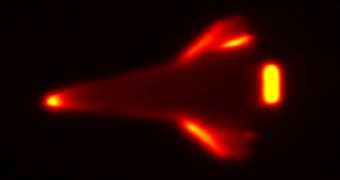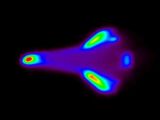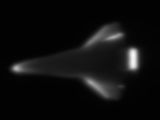When analyzing the risks associated with spaceflight, the landing and taking-off of a spacecraft are the essential moments. All the things that can go wrong at a launch will do so, and it's the job of engineers to ensure that the crews are safe. However, the landing sequence is highly complex, and arguably the most dangerous stage of a spaceflight.
A thin heat shield is the only thing standing between astronauts and certain death, at the hand of extreme temperatures, which exceed 5,500 degrees Celsius. At the end of the STS-128 flight to the ISS, experts snapped a few thermal images of the space shuttle Discovery, in order to get more clues on how to design more efficient heat shields for future missions.
Researchers at the American space agency used advanced observation equipment for the task. The instruments were mounted on a Navy aircraft that followed a trajectory allowing it to snap underbelly photos of Discovery, using thermal filters. The images again show the extreme heat the ceramic shield tiles are subjected to. However, the new observations were made even more interesting by the fact that the “boundary layer transition” (BLT) experiment flew with this mission.
For this study, one of the ceramic tiles in the shield was modified, so that it modified the air flow beneath the spacecraft, creating gas turbulences. Its effects are clearly seen in the recent images, at the top of them, just below the wing's leading edge. The new observations will be added to the growing database of such studies that NASA has. STS-128 is the third flight to get such an image, as experts plan to completely map the gas flow underneath the wings, in 3D, Technology Review reports.
“We want to understand peak temperatures, when they happen and where, because that determines the type of material for, and size of, a protection system,” Thomas Horvath explains. He is the principal investigator of the Hypersonic Thermodynamic InfraRed Measurements (HYTHIRM) project, managed by the NASA Langley Research Center, in Hampton, Virginia. “I certainly think [the researchers] can learn something about what causes the heating,” Stanford University Professor of Physics and Applied Physics Douglas Osheroff adds.

 14 DAY TRIAL //
14 DAY TRIAL // 

